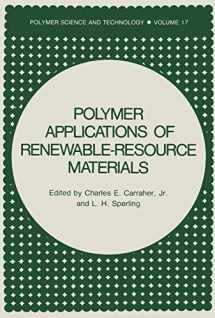
Polymer Applications of Renewable-Resource Materials (Polymer Science and Technology Series, 17)
ISBN-13:
9781461335054
ISBN-10:
1461335051
Edition:
Softcover reprint of the original 1st ed. 1983
Author:
L. H. Sperling, Charles E. Carraher Jr.
Publication date:
2013
Publisher:
Springer
Format:
Paperback
482 pages
FREE US shipping
Book details
ISBN-13:
9781461335054
ISBN-10:
1461335051
Edition:
Softcover reprint of the original 1st ed. 1983
Author:
L. H. Sperling, Charles E. Carraher Jr.
Publication date:
2013
Publisher:
Springer
Format:
Paperback
482 pages
Summary
Polymer Applications of Renewable-Resource Materials (Polymer Science and Technology Series, 17) (ISBN-13: 9781461335054 and ISBN-10: 1461335051), written by authors
L. H. Sperling, Charles E. Carraher Jr., was published by Springer in 2013.
With an overall rating of 4.2 stars, it's a notable title among other
books. You can easily purchase or rent Polymer Applications of Renewable-Resource Materials (Polymer Science and Technology Series, 17) (Paperback) from BooksRun,
along with many other new and used
books
and textbooks.
And, if you're looking to sell your copy, our current buyback offer is $0.3.
Description
For there is hope of a tree, If it be cut down, That it will sprout again And that the tender branch Thereof will not cease. Job XIV (7) Mankind has been blessed with a multitude of resources. In the beginning he utilized almost soley replenishable items such as vegetation and animal protein, for both nourishment and shelter. Gradually, such metals as copper and iron were developed and replaced wood as a material of construction. Cement and glass, although more plentiful than other minerals, also replaced the use of growing sub stances. Coal and oil became the primary sources of heat and power. Closer to the focus of this book, petroleum products began to replace the vegetable oils, tannin, wool, cotton, leather, silk, rubber, etc. in a host of applications. Surely, it was argued, the new materials did the job better and cheaper. What they didn't say is that soon we would run out of oil. In any case, research on growing natural products, now called renewable resources, slowed, and these industries sought only to maintain their status quo. The 20th Century saw an unprecedented emphasis and dependence on nonrenewable resources as energy sources (petroleum, coal, ura nium) and the fabric of technology (drugs, clothing, shelter, tires, computer parts). The predawn of the 21st Century brings a reali zation that a cyclic shift back towards the use of renewable re sources for technological application is in order.


We would LOVE it if you could help us and other readers by reviewing the book
Book review

Congratulations! We have received your book review.
{user}
{createdAt}
by {truncated_author}


